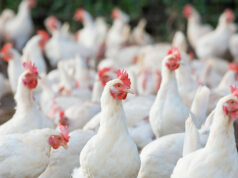The Filipino banig: more than just decor
THE INITIAL idea was to use the 40 banigs — mats which had been woven in Basey, Samar — as gifts and room decor. It was the plan when Philippine Ambassador to Portugal Celia Anna M. Feria arrived in Lisbon in May 2017 to assume her post.
“I brought along with me about 40 pieces of Basey banig [mats] to Lisbon with the intention of giving them away as gifts, and also to use as decoration at the residence and at the Embassy, which I eventually did at the latter,” Ms. Feria told BusinessWorld in an e-mail last month. “I had thumbtacked about eight banig on the walls and on the bookcases in the Embassy’s conference room, while using the others are table highlights when we had Filipino food promotion activities outside the Embassy.”
Then Asian art and textile historians from the Center for Humanities at the University Nova de Lisboa (CHAM) — who frequently visited the embassy for meetings and to participate in various embassy activities — came up with the suggestion to hold an exhibition focusing on the traditional mats.
“I was very surprised at their proposal not thinking much of why they wanted a banig exhibit… Then it made me realize that what for me was ‘just a humble banig’ was in fact a work of art,” Ms. Feria wrote.
THE BASEY BANIG
It was after Super Typhoon Yolanda (international name: Haiyan) devastated the Visayas in 2013 that Ms. Feria began collecting mats in support of the community of women weavers in Basey, Western Samar which was one of the badly affected municipalities.
The municipality of Basey is known for its unique handwoven mats made using the leaves of the tikog, a reed grass with triangular stems which grows in vegetative wetlands.
“I knew the story behind the devastation of Basey as a result of Typhoon Yolanda in 2013, which made me order the banigs in the first place, as a way to help the community of women weavers and embroiders. But what I did not realize was that the banig mats spoke to these experts in a way it hadn’t to me,” Ms. Feria wrote.
In November 2019, the exhibition Banig: A Living Tradition of Mat Weaving for over 500 Years opened at the Fundaçāo Ricardo Espirito Santo Silva (FRESS), a decorative arts museum in Alfama, Lisbon.
The exhibit is meant “to promote the Philippine cultural identity and entrepreneurship in Portugal and to also commemorate the 500th Anniversary of the Circumnavigation of the World by the Magellan/Elcano expedition,” a press release explains.
Thirty-five of the ambassador’s personal banig collection are hung on the museum’s walls
For the exhibit, the 1525 manuscript Primo Viaggio Intorno ad Mondo by Italian chronicler Antonio Pigafetta was used to trace a historical connection around the mats.
Banig historian Elmer Nocheseda said that “the banig or Philippine mat played an important role in receiving Portuguese-born explorer Ferdinand Magellan by local chieftains” in the islands of Cebu in 1521. Mr. Nocheseda noted that on several occasions, Pigafetta cited that “Magellan ate, slept and was warmly received on the banig.”
“This made the entire project very interesting from a historical perspective. It meant that our banig weaving tradition pre-dates colonial Philippines,” Ms. Feria wrote for the exhibit.
Exhibit curator Albert Avellana noted that the selection of mats were chosen by the museum.
“Pagdating ko doon, first time ko nakita ’yung space. I had a preview (of the mats) through images pero doon ko lang nakita ’yung collection na pinili ng museum for the exhibit (When I arrived, it was my first time to see the space. I had a preview of the mats through images but I only saw the items from the collection chosen by the museum for the exhibit),” Mr. Avellana told BusinessWorld in an interview in December.
Mr. Avellana based the design of the space according to the type of banig designs based on the Mr. Nocheseda’s notes.
According to Nocheseda’s evaluation of Ms. Feria’s collection, the patterns include dahun-dahun, Nuhud-tuhud, Amakan, Maharlika, Pintados, Morado, and Bitig.
THE PORTUGUESE RECEPTION
Ms. Feria and Mr. Avellana observed that the Portuguese community was amazed that banigs are an integral part of Filipino culture. Ms. Feria explained to guests how Filipinos utilize the mats for sleeping, eating, playing, and decoration.
“Para sa atin (for us), the banig is [the] usual,” Mr. Avellana said. “[Sometimes] whatever is nearest you, hindi mo napapansin ang value (You do not notice the value).”
The exhibit will not be coming home to Manila, Ms. Feria said since there are more embroidered mats in the country that can be exhibited.
“My collection is limited to post-Yolanda Basey banigs and are relatively new. I am sure that there are more important banig collectors in the Philippines. What I can do is lend my collection to institutions in Europe who would like to borrow the collection for exhibition purposes,” she wrote.
In continuing to promote Philippine culture in Portugal, the embassy is currently working on a bibliography tracing the history of the Philippines and Portugal done in partnership with the Center for Humanities (CHAM) of the Universidade Nova de Lisboa. Researchers and historians are gathering documents and manuscripts that, Ms. Feria wrote, “will help us see our history from another perspective, thereby enriching our knowledge of our past.”
The exhibit runs until Jan. 6, 2020 at the Fundaçao Ricardo do Espirito Santo Silva (FRESS) located at Largo das Portas do Sol, 2 Lisbon, Portugal. — Michelle Anne P. Soliman



